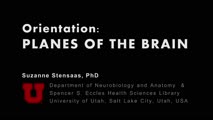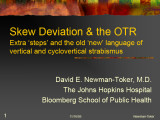Collection of materials relating to neuro-ophthalmology as part of the Neuro-Ophthalmology Virtual Education Library.
NOVEL: https://novel.utah.edu/
TO
- NOVEL981
Filters: Collection: "ehsl_novel_novel"
| Title | Creator | Description | Subject | ||
|---|---|---|---|---|---|
| 426 |
 |
The Most Important Pathway: Motor Control: Neuroanatomy Video Lab - Brain Dissections | Suzanne S. Stensaas, PhD | The origin of the corticospinal tract in the cerebral cortex is traced through gross sections of the hemisphere and brain stem to the spinal cord. Using an animation, the terms upper and lower motor neuron are defined and clinical signs and symptom listed. | Corticospinal Tract; Cerebral Cortex; Motor Neuron; Brain; Dissection |
| 427 |
 |
The Unfixed Spinal Cord: Neuroanatomy Video Lab - Brain Dissections | Suzanne S. Stensaas, PhD | The spinal cord's relationship to the foramina, discs and spinal nerves is demonstrated on a model. The dura, ganglia and rootlets are shown as well as the gray and white matter in gross sections at different levels. A model of the cord is used to demonstrate and describe the anatomy of a monosynapt... | Unfixed Spinal Cord; Spinal Cord; Brain; Dissection |
| 428 |
 |
Olfactory System: Neuroanatomy Video Lab - Brain Dissections | Suzanne S. Stensaas, PhD | Beginning with the location of the sensory cells within the skull the axons are traced into the cranial cavity. Demonstration of the olfactory bulb, olfactory tract and it termination in the forebrain and temporal lobe are indicated. Trauma and meningiomas can produce loss of small (anosmia). Degene... | Olfactory System; Olfactory Bulb; Anosmia; Brain; Dissection |
| 429 |
 |
The Meninges: Neuroanatomy Video Lab - Brain Dissections | Suzanne S. Stensaas, PhD | The epidural, subdural and subarachnoid spaces are demonstrated and discussed with respect to trauma and disease. The relationship of the brainstem and cerebellum to the tentorium demonstrates the vulnerability of the brain stem to increased supratentorial pressure and herniation. Arachnoid granulat... | Meninges; Brain; Dissection |
| 430 |
 |
Orientation: The Planes of the Brain: Neuroanatomy Video Lab - Brain Dissections | Suzanne S. Stensaas, PhD | Terms such as anterior, posterior, inferior and superior are introduced with respect to the hemispheres as well as the brain stem. Terms such as rostral and caudal or dorsal and ventral can mean different things in different areas. Sections in three planes (frontal, axial, and sagittal) are demonstr... | Frontal; Axial; Sagittal; Brain; Dissection |
| 431 |
 |
The Visual Pathway: Neuroanatomy Video Lab - Brain Dissections | Suzanne S. Stensaas, PhD | A brief review of the anatomy of the eye and the photic stimulation of the receptors is followed by a gross exploration of the visual pathway from the optic nerve, chiasm, and tract to the thalamus stressing how the left part of the visual world reaches the right hemisphere. Visual fields are relate... | Visual Pathway; Brain; Dissections |
| 432 |
 |
The Normal Unfixed Brain: Neuroanatomy Video Lab - Brain Dissections | Suzanne S. Stensaas, PhD | The consistency and vulnerability of the brain is demonstrated along with the clear and glistening pia and arachnoid and the tough dura. The cushioning function of the CSF is stressed and the features are pointed out on the ventral surface. The uncus and temporal lobes are normal with arteries free ... | Brain; Dissections |
| 433 |
 |
Skew Deviation and the Ocular Tilt Response | David Newman-Toker, MD, PhD | The objectives of this presentation are to provide an understanding of the current use of the terms "ocular tilt reaction" and "skew deviation," to create some familiarity with the anatomic and physiologic substrate of ocular tilt and skew, and to demonstrate how to distinguish between skew and isol... | Vertical Strabismus; Cyclovertical Strabismus; Skew Deviation; Vestibulo-ocular Reflex; Ocular Tilt Reaction; Vestibular Pathways; Vestibular Ocular System |
| 434 |
 |
Cogan's Lid Twitch Sign | Raed Behbehani, MD | Cogan's lid twitch sign is a twitch sign of he upper lid upon looking straight from a sustained downgaze position. It is associated with Ocular Myasthenia Gavis. | Myasthenia; Ptosis; Lid Twitch |
| 435 |
 |
Carotid Cavernous Fistula | Adam Botwinick, MD; Rudrani Banik, MD | Power point of case presentation of 66-year-old female with chronic red eye OU x 2 months, misdiagnosed as conjunctivitis. Exam showed dilated, tortuous episcleral vessels OU with proptosis OU and elevated intraocular pressure. MRI showed suspicion of carotid cavernous fistula (CCF), confirmed by ... | Carotid Cavernous Fistula; Dural CCF; Chemosis; Corkscrew Vessels; Proptosis; Embolization; Neurointerventional Radiology |
| 436 |
 |
Bitemporal Hemianopia | Julia Mathew Padiyedathu, MD; Rudrani Banik, MD | Power point of case presentation of patient with painless progressive vision loss, optic nerve cupping with pallor and history of significant alcohol and tobacco use. Patient initially diagnosed at outside institution with normal tension glaucoma and toxic optic neuropathy. Exam suggests bitempora... | Ditemporal Visual Field Defect; Toxic Optic Neuropathy; Pituitary Adenoma; Compressive Optic Neuropathy |
| 437 |
 |
Supranuclear and Infranuclear Motility Disorder | Brittany Lin, MD; Rudrani Banik, MD | Power point of case presentation of patient with supranuclear left gaze preference from frontotemporal CVA (overcome by Doll's head), as well as right sixth nerve palsy with incomitant esotropia from pontine CVA. | Supranuclear Gaze Palsy; Sixth Nerve Palsy; Esotropia; Gaze Preference; Stroke |
| 438 |
 |
Thyroid Eye Disease | Helen Jiang MD; Rudrani Banik MD | Power point of case presentation of 50 year old male with newly diagnosed hyperthyroidism who presents with ocular hypertension, acute onset proptosis and visual loss. Diagnosed with thyroid eye disease and compressive optic neuropathy. Treatment options discussed for visual loss in thyroid eye dis... | Thyroid Eye Disease; Compressive Optic Neuropathy; Proptosis; Ocular Hypertension |
| 439 |
 |
Pituitary tumor_Telugu | North American Neuro-Ophthalmology Society | Pituitary tumors are benign (non-cancerous) overgrowth of cells that make up the pituitary gland (the master gland that regulates other glands in the body). | Pituitary Tumor; Patient Brochure |
| 440 |
 |
Microvascular Cranial Nerves Palsy (Italian) | North American Neuro-Ophthalmology Society | Microvascular cranial nerve palsy is one of the most common causes of double vision in the older poulation. They are often referred to as "diabetic" palsies. They will resolve without leaving any double vision. | Microvascular Cranial Nerve Palsy; Patient Brochure |
| 441 |
 |
Hemifacial Spasm (Italian) | North American Neuro-Ophthalmology Society | Involuntary contractions, called "spasms," of the muscles on one side of the face. The affected side of the face seems to "scrunch up" while the other side of the face remains normal. | Hemifacial Spasm; Patient Brochure |
| 442 |
 |
Pituitary Tumor (Italian) | North American Neuro-Ophthalmology Society | Pituitary tumors are benign (non-cancerous) overgrowth of cells that make up the pituitary gland (the master gland that regulates other glands in the body). | Pituitary Tumor; Patient Brochure |
| 443 |
 |
Pseudotumor Cerebri IIH (Italian) | North American Neuro-Ophthalmology Society | This is a condition in which high pressure inside your head can cause problems with vision and headache. | Pseudotumor Cerebri; Patient Brochure |
| 444 |
 |
Pseudotumor Cerebri (Telugu) | North American Neuro-Ophthalmology Society | This is a condition in which high pressure inside your head can cause problems with vision and headache. | Pseudotumor Cerebri; Patient Brochure |
| 445 |
 |
Optic Disc Drusen (Italian) | North American Neuro-Ophthalmology Society | Optic disc drusen are abnormal deposits of protein-like material in the optic disc - the front part of the optic nerve. | Optic Disc Drusen; Patient Brochure |
| 446 |
 |
Migraine (Italian) | North American Neuro-Ophthalmology Society | Headache on one or both sides of the brain, and may include symptoms of nausea, vomiting, and sensitivity to light. | Migraine; Patient Brochure |
| 447 |
 |
Neuropatia Ottica Ischemica Anteriore (AION) (Italian) | North American Neuro-Ophthalmology Society | Loss of blood supply to the optic nerve results in diminished visual acuity. | Anterior Ischemic Optic Neuropathy; Patient Brochure |
| 448 |
 |
Blefarospasmo Essenziale Benigno (Italian) | North American Neuro-Ophthalmology Society | Uncontrolled blinking, squeezing, and eyelid closure that occurs in both eyes without an apparent environmental cause. | Blepharospasm; Patient Brochure |
| 449 |
 |
Optic Neuritis (Italian) | North American Neuro-Ophthalmology Society | In the most common form of optic neuritis, the optic nerve has been attacked by the body's overactive immune system and results in decreased vision. | Optic Neuritis; Patient Brochure |
| 450 |
 |
Optic Neuritis (Telugu) | North American Neuro-Ophthalmology Society | In the most common form of optic neuritis, the optic nerve has been attacked by the body's overactive immune system and results in decreased vision. | Optic Neuritis; Patient Brochure |
